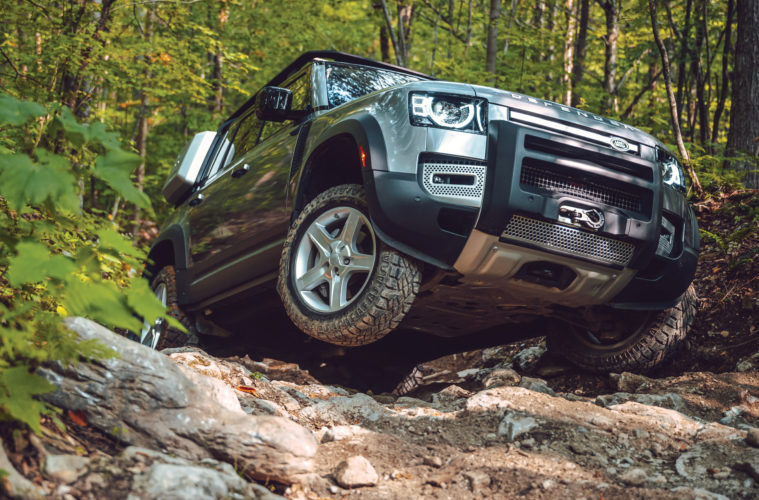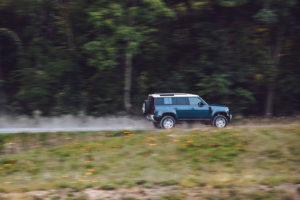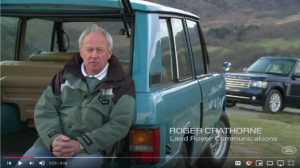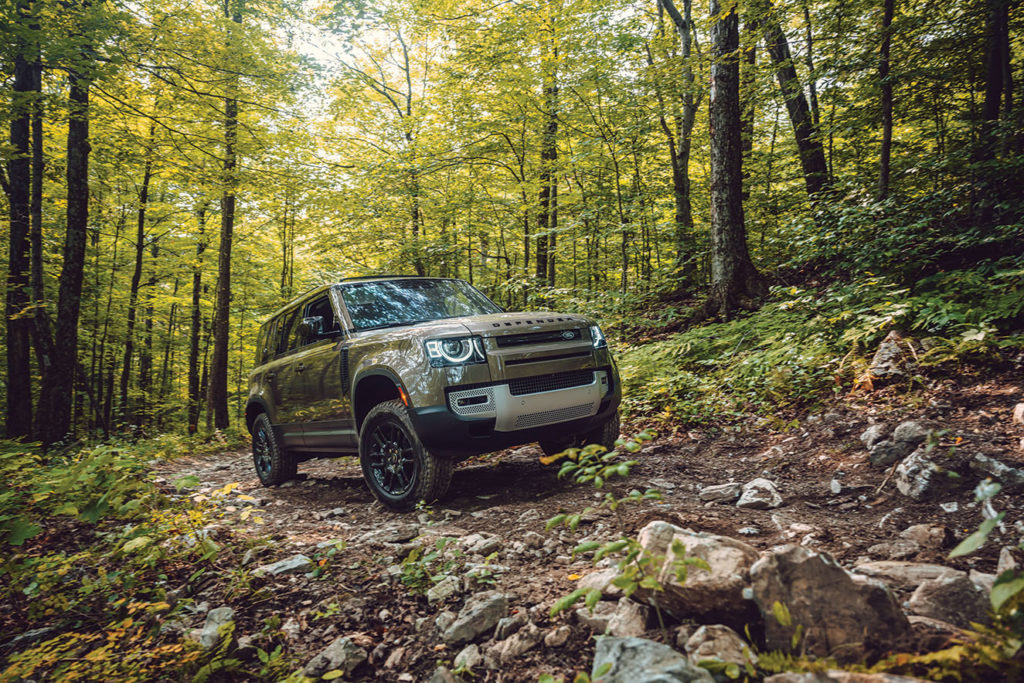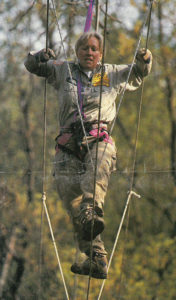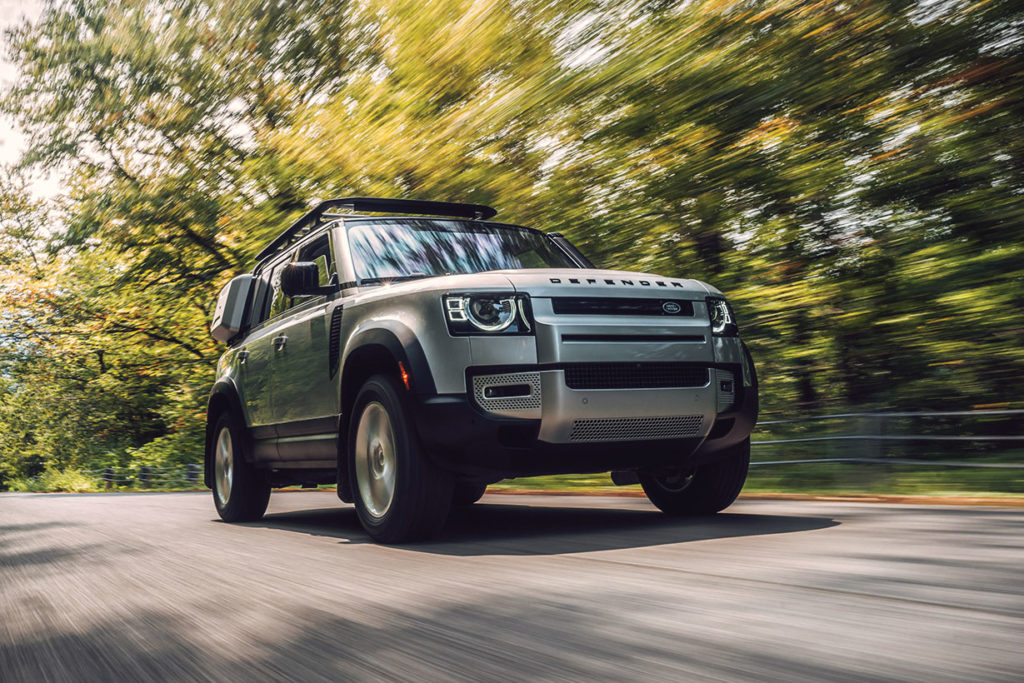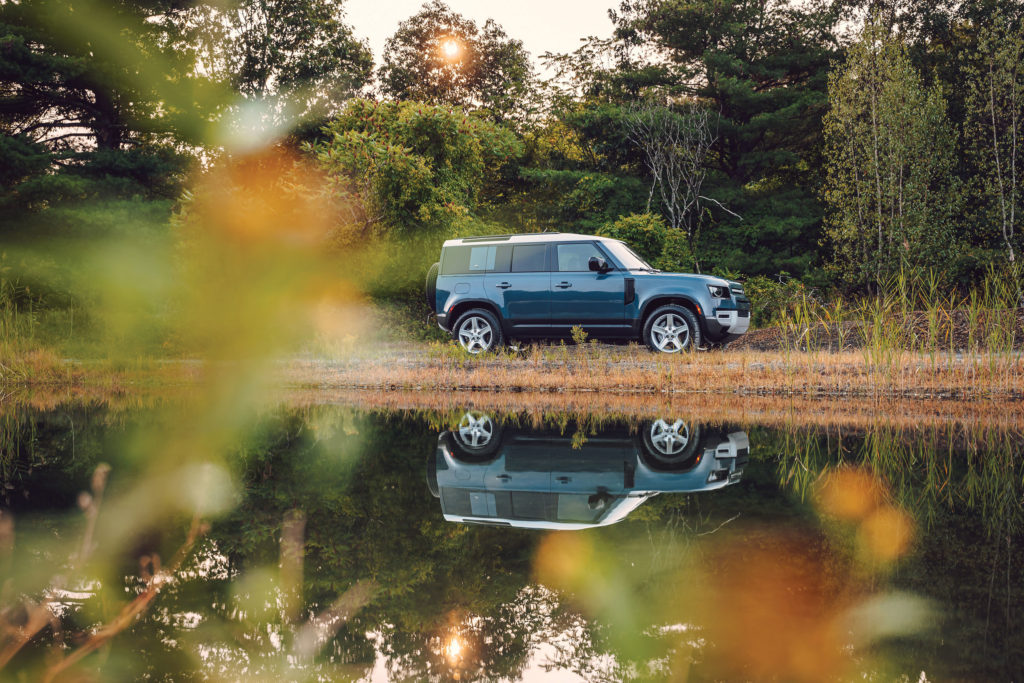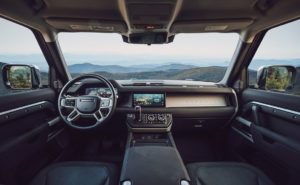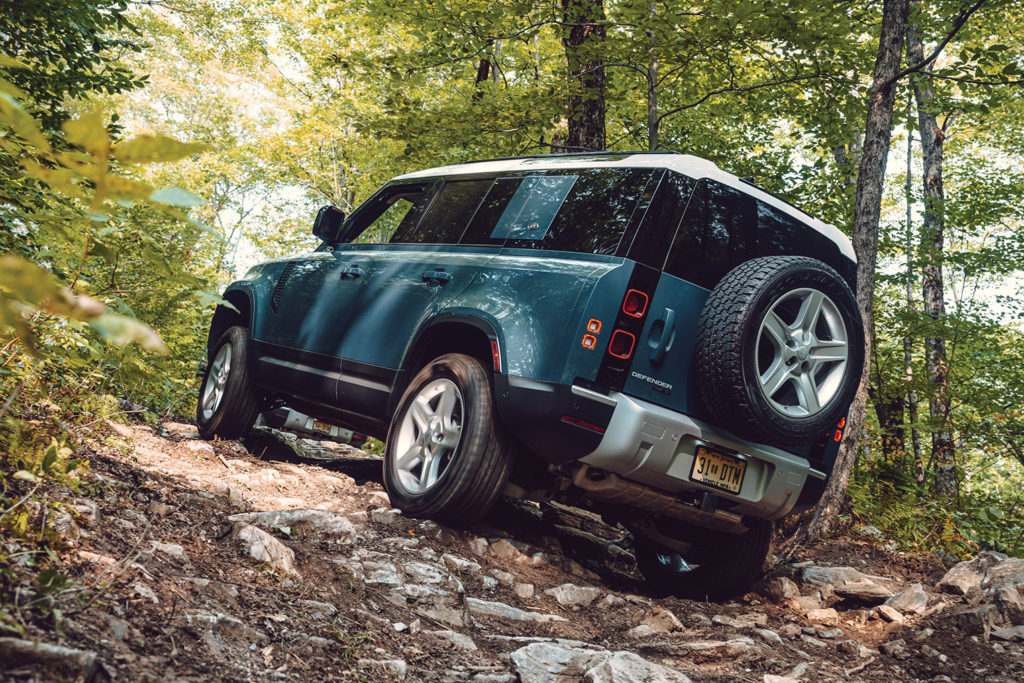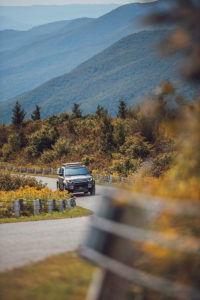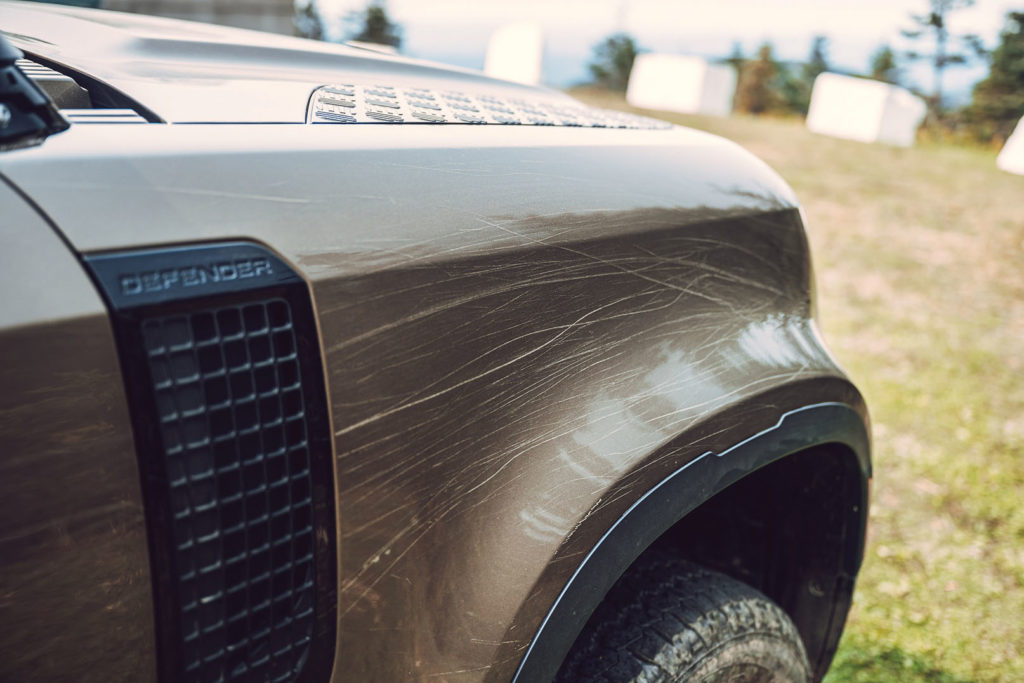2020 provides the perfect example of the Latin phrase, Annus Horribilis. For Land Rover, 2020 has been an Annus Interrumpi. JLR made a big splash at the Frankfurt and Los Angeles Auto Shows in the fall of 2019, and a tsunami at the January 2020 4xFAR Festival in California. Then came the pandemic, the cancellation of the Global Media Launch event in the UK last March, the closure of the Nitra factory, and a long halt to Defender deliveries worldwide.
Finally, after much scrambling with safety precautions and differing state restrictions, JLR created a media drive in September and invited Rovers Magazine to the first round of road tests. Our route took us through 500 miles of interstate, two-lane, and dirt roads, from JLR headquarters in New Jersey through New York, Vermont, and western Massachusetts, with 6 hours of off-road driving time over the three-day event.
Ron Filipovic, JLR’s Director of Product Planning, stated, “Land Rover needs to appeal to a broader customer base” with the new Defender, but has not ignored the off-road capability necessities: the ability to climb a 45-degree gradient, 19.7-inch articulation, 35-inch wading depth, 38-degree approach and 40-degree departure angles, two-speed transfer case, center, and rear locking differentials, and an 8,200-pound towing capacity. The information looked fine on paper [see Holiday 2019 issue for specifications -ed.], but the execution is all.
That’s why we’ve collected additional road tests from other automotive journalists.
Roger Crathorne
Born in Solihull, Roger Crathorne didn’t ask for the title, “Mr. Land Rover,” but given his decades of service to Land Rover, he’s earned it. From helping to engineer the first Range Rover to leading Land Rover’s off-road events and training, he continues to represent the marque worldwide. He currently owns a 1951 Series I and a 2016 Heritage Defender, so we asked in a phone interview for his thoughts on the new Defender.
Q: What is your overall feeling about the new Defender?
A: “Land Rover will always improve on what has come before and never compromise on its off-road performance. The new Defender will, I think, be the benchmark that other manufactures will have to follow. Its new packaging and the engineering will make this vehicle a must-have for all users and it will put their dreams into reality.”
Q: Enthusiasts are skeptical as to whether the new vehicle represents the essence of the Defender. What is your response?
A: “The classic Defender and the new Defender sprung from the same engineers, who share the same values and attributes of their predecessors. The new Defender is the right vehicle for 2020, as the Series I was for 1948. Whether it’s my Heritage Defender or the new Defender 110, both were created as people carriers that were, and are, right for their times. If the creature comforts and fittings are greater, it’s because the world markets call for them.”
“For farmers, commercial users and aid organizations, we do have a panel-side model, available in both the Defender 110 and 90 models.” [These vehicles have no rear seats and are available in the UK -ed.]
Q: Land Rover confronted enormous challenges in creating the new Defender. What are some of those challenges that interested you?
A: “We used to have to modify the Defender’s lighting, emissions, engine and drivetrains, and interiors to meet different national regulations. Unlike previous Defenders, this one is a world vehicle; it meets all the regulatory requirements for every market. Getting that right is one reason that it took longer to bring it to market.”
“On a smaller level, I was impressed that our engineers could create a middle seat option in the front row that included the required 3-point seatbelt. The middle jump seat was a hallmark of the original Defenders and Series vehicles.”
Q: The new Defender is inherently more complex than the classic Defender. Do you think that presents problems for travel in remote areas?
A: “I’d have absolutely no hesitation to take a new Defender on an expedition anywhere in the world. This vehicle will not disappoint those who take it on their next adventure.”
“You know, journalists often claim that newer Land Rovers are ‘very difficult to work on.’ I heard the same complaint when Land Rover introduced Electronic Traction Control for the 1993 Range Rover. [Electronic Traction Control works in conjunction with the ABS system, and is a field repair if necessary -ed.] ETC provided our customers with a definite advantage in difficult off-road situations, and owners and mechanics learned how to work on those systems. The new Defender’s connectivity enables Land Rover to diagnose and likely correct a problem anywhere in the world.”
“Look, the classic Defender was created at a time when you had to schedule an international call day in advance. Now we’re holding an international call on our cellphones. We live in an environment in which we’re speaking instantly. The new Defender takes advantage of this connectivity, should a repair be necessary, as it’s able to monitor and diagnose remotely.”
Sue Mead
Let me state, unequivocally, that I’m in love with the classic Defender.
When I was selected as a participating journalist for the 1995 U.S. Camel Trophy team — the first time the Camel Trophy allowed women — I joined a culture and stepped into a slipstream that catapulted my career and changed my inner being forever. The 30-hour, non-stop tryout began in frigid temperatures at an elevation of 5,000 feet in Grand Junction, CO, starting with a 5:00 AM swim and ended after distance runs, navigation tasks, slinging myself across a ravine on a rope, and driving and winching exercises through deep water and mud pits — in the black of night. The actual “Mundo Maya” was close to a 180-degree difference! The rainforest was nearly bone-dry in the five Central American countries we traversed, but my 1,000-mile journey in a Land Rover Discovery challenged every alert system in my body and brain with sweltering heat and humidity, venomous snakes, spiders and scorpions, and the occasional food-and-water-borne ills that are a staple of expedition life. Twenty teams in “Discos” and a cadre of support staff in Defenders participated that year. The Discovery was my home-away-from-home; it accommodated our four-person team and gear and even provided a sleeping bed for my short-statured body. I appreciated the kinship between the North American Discovery I and Defender as they shared a common drivetrain.
It was my second Camel Trophy in 1996 that was the most life-changing. Year two, I loaded my two Pelican cases and camera gear into a 110 and departed the port city of Balikpapan, Borneo, for a 1,000 slog across a dense and danger-filled tropical landscape to the white sand beaches of Pontianak in the Kalimantan region, often identified with its indigenous Dayak tribe and bands of orangutangs. This time, I felt high-on-the-hog to be invited to ride along in a Defender 110; this tall, stalwart support vehicle. I felt less daunted by the things that would bite and sting and more confident in the Defender’s peerless ability to get through thigh-deep mud, climb steep ravines, and motor with precision over log bridges. Thus began my secret love affair with the 110. I was enamored with its classic out-of-Africa visual imprint, the nuts-and-bolts interior made for ferrying people and stowing the basics, the diesel rumble on start-up, the slightly rambling-ride on coils that could be reined in for prowess, when needed, and the two-speed gearbox with a locking center diff.
I went on to motor through 45 countries with Land Rover on other Camel Trophys, Treks, G4 Challenges, recces, and a smattering of grand adventures in Discoverys, Freelanders, and Range Rovers. Workhorse Defenders accompanied us on most of these journeys and I always climbed aboard one for an opportunity to renew my relationship with them. My career and passion also led to off-road racing and other extreme expeditions in almost six dozen countries, with a wide variety of vehicles that were purpose-built for the task at hand. In some of the far-flung locations on my travel map, I would cut my eye when I would see a Defender; I would long to take it for a ride.
My heart swelled when I was invited to test out the new Defender 110, but I wondered if it would be too rarified for my blood? I knew that I would be trading my wellies for Merrells and the red-clay mud of Borneo for the glistening hallways of Jaguar Land Rover headquarters in Mahwah, NJ. That’s where the three-day motoring event started and would conclude with a few hundred miles of highways and byways. But, what would I find when I took it to the wooded trails and technical course of the Land Rover Experience Center in Manchester, VT, and drove it over slippery rock patches of an incline up nearly 4,000-feet of the Mt. Equinox range?
I was shy in coming to like its looks but slowly warmed up as I found some of the original upright-brick imprints in its genetics. I’ve grown older now, too, and I had to admit that it was an easy climb-aboard, with great ergonomics to keep me in place and my gear at hand. I quickly warmed up to its comfort and convenience features, navigation aids, heads-up display, audio, and a heated seat that cossetted my back and bottom. Off-pavement, Configurable Terrain Response, and a collection of traction aids worked faster and more efficiently than I could. Cameras guided my wheel placement. Angles of approach, departure, and break-over created a footprint that made ease for every task along our backcountry tracks and woodland trails.
Long-awaited, the Defender is back. The legend and lore carry forward in a new body with new brains made for the 21st century. It’s a new day and today’s Defender buyers want to make their own adventures and select accessories that accommodate their everyday lifestyle and their choice of either small or large overlanding adventures. Old-school Defenders motor on around the globe and will, seemingly forever. I will always hold them in a special place in my heart, but I just might grow to like the PIVI infotainment system, and ask the navigation to guide my tires across a series of GPS waypoints to keep the red-clay mud off of my hiking boots!
[Sue Mead, Williamstown, MA, continues her decades-long career as a highly-respected automotive journalist, specializing in off-roading and competitive rallies.]
Jeffrey Aronson
I stared at a Tasman Blue Defender 110 SE, with seating for five and an MHEV 3.0 L inline 6-cylinder [395 HP, 406 lb-ft torque] that was to be mine for the long weekend. I’m not a fan of the angular lines, particularly in the front, but then I’m wedded emotionally to my Series IIA’s. However, I am a fan of the .39 Cd, which helps the 110 achieve an EPA highway reading of 22 mpg highway/ 17 mpg city — compared with the NAS Defender 110s 12 mpg.
The list of standard equipment looked extensive, but if you want the Electric Active Differential, off-road-oriented tires, and a 120V socket in the rear, you’ll add the Off-Road Pack ($1,345). The Advanced Off-Road Capability Pack ($735) includes All-Terrain Progress Control — to help maintain a constant walking speed when off-road — and Configurable Terrain Response 2, to create your own settings. For work, off-road excitement, and expeditions, Land Rover offers an optional Winch Kit ($5,399, plus eight hours installation for the Warn winch, bumper, A-bar, and Bluetooth controller).
The new Defender 110 actually has a 119-inch wheelbase, with an additional 16 inches of overall length and 8 inches of width over the classic Defender 110. The rear seats fold flat, providing for greater gear storage — 69 inches from the rear door to the front seats and 48 inches between the wheel wells. The rear door opening measures 35 inches high and 39.5 inches wide, slightly less than the classic Defender 110. In the end, you trade 2 inches of height and 4 inches of length for a 10-inch gain in interior width. That’s still a lot of kit or supplies.
At 4,865 lbs., it’s only 17 pounds heavier than its predecessor. All the physics, along with independent front and rear suspensions, made for a nimble yet firm-riding highway vehicle. Nothing in the suspension isolates you from the road. You’ll smile as you feel every expansion strip or macadam repair, but unlike the classic Defender, the ride politely nudges you about road imperfections rather than thumping them at you. On-road and off-road, you’ll benefit from the 2.7 turns lock-to-lock steering and the 42 ft turning circle, an improvement over the classic Defender’s 4.0 turns and 47 ft turning circle.
I signed waivers promising to obey all speed limits and road signs, so I did not test the claimed top speed of 119 mph (NAS Defender 110’s top speed was 89 mph.) Acceleration felt like a 0-speeding ticket in no time; Land Rover claims 0-60 in 5.8 seconds, thanks to the electric supercharger and twin turbos. The beloved NAS 110 required 12.3 seconds and a leisurely 22 seconds to accelerate from 50-70 mph.
Inside the Defender felt like, well, a Defender. You can sit upright, see over the edge of the hood, and the rearview mirror/camera provide an adequate view behind. I didn’t miss the British Leyland-style plastic and rubber fittings of the NAS Defender. The interior fitments aren’t gimmicks; they’re purposeful and useful, including the grab handles, mesh storage pockets, and door cubbies, with lots of auxiliary sockets for the electronic gear we travel with today. Lift the snaps on the floor mats and, thanks to the equal sill height, you can wash out the rubberized floors throughout the vehicle.
The Defender proved very competent in the combined 6 hours of off-road driving at the Land Rover Experience Center in Manchester, VT. A Land Rover Driving team, comprised of Sean Gorman, Tim Hensley, Warren Blevins, Ramsey Benson and Travis Martin, joined Land Rover Experience instructors David Nunn, Chrystyna Young, and Lindsey Chambeau in selecting existing trails and creating new ones for the Defender drive.
All the trails rose steeply uphill and fell accordingly downhill, often with sharp turns at their ends; again the turning radius helped belie the vehicle’s extra size on the trails. The new Defender’s ground clearance off-road improves to 11.5 from 9.8 inches through the air suspension. Watching the rear suspension links articulate demonstrated their effectiveness. Unlike the classic Defender/Discovery V8 experience, momentum played only a minor role as the Defender could creep up a steep incline at an indicated 1-3 mph in low-range (automatically engaging the differential lockers), using the rock climb mode. Descents were equally controllable as the cruise control button would increase or decrease speeds. A steady foot on the throttle sent power to the correct wheel at the right moment, even when confronted by loose rocks that spun away under power. While factory-equipped with “off-road tires,” they lacked much side tread bite; Land Rover should look for additional tire options for such a capable vehicle.
I learned new off-road driving techniques from the team of spotters; the Defender’s inherent capabilities changed but did not do away with, driver involvement. The various cameras displayed your progress and wheel positions on the center screen, but you still had to have the spatial awareness to center the vehicle on the trail. I’m eager to try out the 2021 Defender 90 [actually 101.9 inches] when it arrives this coming winter.
The unanswered question is whether an enthusiast in 2050 will jump into their 2020 Defender 110 and undertake an epic adventure, or continue to use them in daily work in remote locations. That’s the hallmark of the Defender to enthusiasts. Only time will tell.
